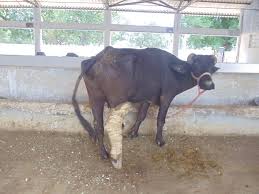Deshila
- Deshila & Punjabiya
- Punjabiya (graded Murrah)
- Deshila (Diara)
- Non-descript (other than above two types)
- Comparative performance of genetically different buffalo populations
- Management Practices
- Housing
Although small buffalo herds are distributed through out the length and breadth of the state but the area under South and North gangetic plains of Bihar is densely populated with clusters of buffaloes, of course, majority of them are not described so non-accredited. In the study area maintenance of history-pedigree records of buffaloes was not in practice. However, on the basis of physical attributes, the farmers usually classify buffaloes into following three distinct groups
(i) Punjabiya (graded Murrah)
(ii) Deshila (Diara) and
(iii) Non-descript (other than above two types)
The results of district-wise studies on some of the traits pertaining to morphometrics, growth, production, reproduction and draft performances of buffaloes in Bihar have been summarized in table-2
Table-2: Least squares means±SE of morphometric, production and reproduction traits of buffaloes in Bihar.
| Parameters | Genetic groups | ||
| Graded Murrah | Diara | Non-descript | |
| Morphometric traits | |||
| Height at wither (cm) | 131.17b±0.53 | 128.34a ±0.49 | 128.55a±0.49 |
| Body length (cm) | 137.59b±0.56 | 134.39a ±0.51 | 134.93a±0.51 |
| Heart girth (cm) | 196.75b ±1.19 | 188.95a±1.08 | 195.34b ±1.09 |
| Body weight (kg) | 497.95a±6.79 | 447.50b±6.35 | 473.23a±6.12 |
| Milk Production traits | |||
| Lactation milk yield (kg) | 1355.87a±30.84 | 1313.82a±28.08 | 1005.04b±28.08 |
| Lactation length (days) | 296.50a±5.60 | 307.71a±5.10 | 314.87a±5.10 |
| Peak yield (kg) | 8.05a±0.21 | 7.50a±0.195 | 6.07b±0.20 |
| Days to attain peak yield | 38.00b±0.52 | 42.00a±0.47 | 44.00c±0.47 |
| Reproduction traits | |||
| Dry period (days) | 108.73a ±2.14 | 115.26a ±1.95 | 132.76b ±1.95 |
| Calving interval (days) | 416.35b±2.67 | 420.53a±2.43 | 436.86a±2.43 |
| Age at first service (days) | 981.75a±8.14 | 1005.33a±7.46 | 1046.05b±7.41 |
| Service period (days) | 101.11a±2.65 | 106.53a±2.41 | 120.71b±2.41 |
| Gestation period (days) | 315.24a±1.37 | 316.71a±1.24 | 314.87a±1.24 |
Values superscripted by different alphabets are significantly (P<0.05) different from each other.
As evident from the table-2 it may be concluded that the Diara buffaloes are more or less equally efficient so far as their production and reproduction efficiencies are concerned. If considered from economics points of view, Diara buffaloes are more economical than graded Murrah because the former are reared under Zero Management System utilizing locally available feeds and fodder resources without any external support. Buffaloes of this type are fully adaptive to the socio-economic conditions of the farmers as well as agro-eco system of the locality. Farmers are getting much more from these animals without any hi-tech management..
Buffaloes in Bihar are housed close to the human dwellings. The housing is either part of the residence or are separately constructed. In most cases, closed housing is provided with thatched roofs covered with paddy straw. Temporary field shelters are also found. Floors are generally uneven without proper drainage facilities. About 85-90% animals are housed at night and rest of the animals are housed both in day and night. The practice of allowing the animals to wallow in the nearby water resources is prevalent. Mostly the animals wallow around noon after grazing in the field.
Feeding
In general, the animals are maintained on grazing and one time stall feeding in the evening was in common practice. Individual feeding was in practice. Physical and Physiological status of the animals like body size, level of milk production, stage of lactation and gestation as well as dry period are the basis of quantum of concentrate mixture fed to a particular animal. Except a few exceptions of feeding branded readymade concentrate mixture like Sudha dana, Kapila Pashu Aahar etc., mostly home made concentrate mixtures are fed to the animals. Linseed /or Mustered cake alongwith cereals (maize, broken wheat etc.), pulses-chunni and wheat-bran are the chief ingredients of concentrate mixture. Besan (pulv gram), molasses/gur and comman salt are also fed to new calver buffaloes. Wheat bhusa and dry Maize straw are the common items of dry fodder. Seasonal cultivated green fodder like Maize and Jwar along with uncultivated green grasses are the main source of green fodder. Green Potato plant as well as leaf of Cauliflower, Cabbage and Pea are also fed to the animals as and when available. Mineral mixture and Calcium preparation are not in common feeding practices in the study area. Although majority of buffaloes in the state are managed under low input system of management but high producing animals are put under superior feeding and managemental conditions, of course under scientific approved practice.
Breeding
Breeding of buffaloes is highly unorganized. Natural service is the only method of breeding being practiced in diara area. A.I. is completely absent and also there is insufficient number of breeding bulls available in the area. In urban and peri-urban areas the farmers have the option for breeding their buffaloes with Murrah buffalo bulls which resulted into higher proportion of graded Murrah in these areas.
Farmers were not fully aware to the scientific and approved package of practices for disease control in buffaloes. The prescribed vaccination schedule was not followed. Ailing animals were treated with mixed medication i.e.of herbal, local and allopathic origin. Use of herbal and local medicines was in practice probably due to non-availability of Veterinary facilities at door steps in rural area as well as relatively higher cost of Allopathic medicines and vaccines.
contributed by SR Singh and KG Mandal

